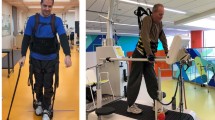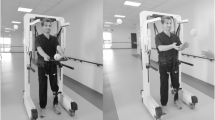Abstract
Study design
A non-randomized open-label single-arm clinical trial.
Objectives
To analyze the effect of body weight supported treadmill training (BWSTT) with the voluntary driven exoskeleton (VDE) in persons with differing levels and completeness of spinal cord injury (SCI) and differing walking abilities.
Setting
Keio University Hospital, Tokyo, Japan.
Methods
Twenty individuals with chronic SCI (age, 43 ± 17 years) classified as American Spinal Injury Association Impairment Scale grade A (n = 2), B (n = 4), C (n = 8), or D (n = 6) who had reached a plateau in recovery. Participants underwent twenty 60 min sessions of BWSTT with the hybrid assisted limb. The speed, distance, and duration walked in every 60 min training session were recorded. The Walking Index for SCI Scale II (WISCI-II), 10 meters walk test (10MWT), 2 min walk test, timed up and go (TUG) test, Berg Balance Scale (BBS), lower extremity motor score (LEMS), Barthel Index, and Functional Independence Measure were evaluated at pre and post intervention.
Results
There was a significant improvement in 10MWT, TUG, and BBS after the intervention. Walking ability significantly improved in participants with high walking ability at baseline (WISCI-II score 6–20; n = 12) but not in participants with low walking ability (WISCI-II score 0–3; n = 8). Significant improvement of BBS was also shown in participants with high walking ability at baseline.
Conclusions
Patients with high walking ability at baseline responded better to the training than those with low walking ability.
Similar content being viewed by others
Log in or create a free account to read this content
Gain free access to this article, as well as selected content from this journal and more on nature.com
or
Data availability
This can be found in the Supplementary Tables 1–1, 1–2, 1–3, and 1–4.
References
Wilson JR, Jaja BNR, Kwon BK, Guest JD, Harrop JS, Aarabi B, et al. Natural history, predictors of outcome, and effects of treatment in thoracic spinal cord injury: a multi-center cohort study from the North American Clinical Trials Network. J Neurotrauma. 2018;35:2554–60.
Dietz V, Colombo G, Jensen L, Baumgartner L. Locomotor capacity of spinal cord in paraplegic patients. Ann Neurol. 1995;37:574–82.
Lam T, Eng JJ, Wolfe DL, Hsieh JT, Whittaker M. A systematic review of the efficacy of gait rehabilitation strategies for spinal cord injury. Top Spinal Cord Inj Rehabil. 2007;13:32–57.
Bach Baunsgaard C, Vig Nissen U, Katrin Brust A, Frotzler A, Ribeill C, Kalke YB, et al. Gait training after spinal cord injury: safety, feasibility and gait function following 8 weeks of training with the exoskeletons from Ekso Bionics. Spinal Cord. 2018;56:106–16.
Colombo G, Wirz M, Dietz V. Driven gait orthosis for improvement of locomotor training in paraplegic patients. Spinal Cord. 2001;39:252–5.
Esquenazi A, Talaty M, Packel A, Saulino M. The ReWalk powered exoskeleton to restore ambulatory function to individuals with thoracic-level motor-complete spinal cord injury. Am J Phys Med Rehabil. 2012;91:911–21.
Winchester P, McColl R, Querry R, Foreman N, Mosby J, Tansey K, et al. Changes in supraspinal activation patterns following robotic locomotor therapy in motor-incomplete spinal cord injury. Neurorehabilit Neural Repair. 2005;19:313–24.
Yang JF, Norton J, Nevett-Duchcherer J, Roy FD, Gross DP, Gorassini MA. Volitional muscle strength in the legs predicts changes in walking speed following locomotor training in people with chronic spinal cord injury. Phys Ther. 2011;91:931–43.
Piira A, Lannem AM, Sorensen M, Glott T, Knutsen R, Jorgensen L, et al. Manually assisted body-weight supported locomotor training does not re-establish walking in non-walking subjects with chronic incomplete spinal cord injury: a randomized clinical trial. J Rehabil Med. 2019;51:113–9.
Piira A, Lannem AM, Sorensen M, Glott T, Knutsen R, Jorgensen L, et al. Robot-assisted locomotor training did not improve walking function in patients with chronic incomplete spinal cord injured: a randomized clinical trial. J Rehabil Med. 2019;51:385–9.
Jansen O, Schildhauer TA, Meindl RC, Tegenthoff M, Schwenkreis P, Sczesny-Kaiser M, et al. Functional outcome of neurologic-controlled HAL-exoskeletal neurorehabilitation in chronic spinal cord. Injury: a pilot one year treat variable treat frequency. Glob Spine J. 2017;7:735–43.
Jansen O, Grasmuecke D, Meindl RC, Tegenthoff M, Schwenkreis P, Sczesny-Kaiser M, et al. Hybrid Assistive Limb exoskeleton HAL in the rehabilitation of chronic spinal cord injury: proof of concept; the results in 21 patients. World Neurosurg. 2018;110:e73–8.
Grasmucke D, Zieriacks A, Jansen O, Fisahn C, Sczesny-Kaiser M, Wessling M, et al. Against the odds: what to expect in rehabilitation of chronic spinal cord injury with a neurologically controlled Hybrid Assistive Limb exoskeleton. A subgroup analysis of 55 patients according to age and lesion level. Neurosurg Focus. 2017;42:E15.
Sczesny-Kaiser M, Hoffken O, Aach M, Cruciger O, Grasmucke D, Meindl R, et al. HAL(R) exoskeleton training improves walking parameters and normalizes cortical excitability in primary somatosensory cortex in spinal cord injury patients. J Neuroeng Rehabil. 2015;12:68.
Aach M, Cruciger O, Sczesny-Kaiser M, Hoffken O, Meindl R, Tegenthoff M, et al. Voluntary driven exoskeleton as a new tool for rehabilitation in chronic spinal cord injury: a pilot study. Spine J. 2014;14:2847–53.
Nakajima T. Cybernic neurorehabilitation using robot suit HAL. Neurol Ther. 2016;33:396–8.
Borg GA. Psychophysical bases of perceived exertion. Med Sci Sports Exerc. 1982;14:377–81.
Dittuno PL, Ditunno JF Jr. Walking index for spinal cord injury (WISCI II): scale revision. Spinal Cord. 2001;39:654–6.
Van Hedel HJ, Wirz M, Dietz V. Assessing walking ability in subjects with spinal cord injury: validity and reliability of 3 walking tests. Arch Phys Med Rehabil. 2005;86:190–6.
Rossier P, Wade DT. Validity and reliability comparison of 4 mobility measures in patients presenting with neurologic impairment. Arch Phys Med Rehabil. 2001;82:9–13.
Matsushima M, Yabe I, Uwatoko H, Shirai S, Hirotani M, Sasaki H. Reliability of the Japanese Version of the Berg Balance Scale. Intern Med. 2014;53:1621–4.
Han JY, Kim JM, Kim SK, Chung JS, Lee HC, Lim JK, et al. Therapeutic effects of mechanical horseback riding on gait and balance ability in stroke patients. Ann Rehabil Med. 2012;36:762–9.
Maynard FM, Jr., Bracken MB, Creasey G, Ditunno JF, Jr., Donovan WH, Ducker TB. et al. International standards for neurological and functional classification of spinal cord injury. Spinal Cord. 1997;35:266–74.American Spinal Injury Association.
Collin C, Wade DT, Davies S, Horne V. The Barthel ADL Index: a reliability study. Int Disabil Stud. 2009;10:61–3.
Hamilton BB, Laughlin Ja Fau-Fiedler RC, Fiedler Rc Fau-Granger CV, Granger CV. Interrater reliability of the 7-level functional independence measure (FIM). Scand J Rehab Med. 1994;26:115–9. 0036-5505 (Print).
Jones ML, Evans N, Tefertiller C, Backus D, Sweatman M, Tansey K, et al. Activity-based therapy for recovery of walking in chronic spinal cord injury: results from a secondary analysis to determine responsiveness to therapy. Arch Phys Med Rehabil. 2014;95:2247–52.
Niu X, Varoqui D, Kindig M, Mirbagheri MM. Prediction of gait recovery in spinal cord injured individuals trained with robotic gait orthosis. J Neuroeng Rehabil. 2014;11:42.
Alamro RA, Chisholm AE, Williams AMM, Carpenter MG, Lam T. Overground walking with a robotic exoskeleton elicits trunk muscle activity in people with high-thoracic motor-complete spinal cord injury. J Neuroeng Rehabil. 2018;15:109.
Kim HS, Jeong HJ, Kim MO. Changes of functional outcomes according to the degree of completeness of spinal cord injury. Ann Rehabil Med. 2014;38:335–41.
Wilcox JT, Satkunendrarajah K, Nasirzadeh Y, Laliberte AM, Lip A, Cadotte DW, et al. Generating level-dependent models of cervical and thoracic spinal cord injury: exploring the interplay of neuroanatomy, physiology, and function. Neurobiol Dis. 2017;105:194–212.
Acknowledgements
We thank Cyberdyne Inc. for their technical support in the use of HAL.
Funding
Our institution received grant from Japan Agency for Medical Research and Development (Grant number: 19bk0104017h0002), Japan Science and Technology Agency (Grant number: 05-001-0002), and the Uehara Memorial Foundation for this study, but all author received no specific funding for this work. The funders had no role in study design, data collection and analysis, decision to publish, or preparation of the manuscript.
Author information
Authors and Affiliations
Contributions
HO and TS conducted evaluation and intervention for all participants, analysis and interpreting the result, and drafting the manuscript. KM was responsible for designing the study protocol, recruiting participants. KS played an important role in interpreting the result and revised the manuscript mainly. OT, NN, and MM played an important role in interpreting the result and revised the manuscript. MN was responsible for all working related to this submission as corresponding author. Also, all authors approved the final version manuscript and agreed to be accountable for all aspects of the work.
Corresponding author
Ethics declarations
Conflict of interest
The authors declare that they have no conflict of interest.
Statement of ethics
We certify that all applicable institutional and governmental regulations concerning the ethical use of human volunteers were followed during the course of this research. The study protocol was conducted in compliance with ethical guidelines for medical and health research involving human subjects and approved by the Ethics Committees of Keio University School of Medicine (Approval no. 20150355).
Additional information
Publisher’s note Springer Nature remains neutral with regard to jurisdictional claims in published maps and institutional affiliations.
Supplementary information
Rights and permissions
About this article
Cite this article
Okawara, H., Sawada, T., Matsubayashi, K. et al. Gait ability required to achieve therapeutic effect in gait and balance function with the voluntary driven exoskeleton in patients with chronic spinal cord injury: a clinical study. Spinal Cord 58, 520–527 (2020). https://doi.org/10.1038/s41393-019-0403-0
Received:
Revised:
Accepted:
Published:
Issue date:
DOI: https://doi.org/10.1038/s41393-019-0403-0
This article is cited by
-
Exoskeleton-based exercises for overground gait and balance rehabilitation in spinal cord injury: a systematic review of dose and dosage parameters
Journal of NeuroEngineering and Rehabilitation (2024)
-
Wearable powered exoskeletons for gait training in tetraplegia: a systematic review on feasibility, safety and potential health benefits
Acta Neurologica Belgica (2022)
-
Cybernic treatment with wearable cyborg Hybrid Assistive Limb (HAL) improves ambulatory function in patients with slowly progressive rare neuromuscular diseases: a multicentre, randomised, controlled crossover trial for efficacy and safety (NCY-3001)
Orphanet Journal of Rare Diseases (2021)



